As the summer months progress, caterpillars begin to show up. They are often seen munching on plants around the country. Although most of these insects are harmless, some can bite or even sting you. Most caterpillars have hollow stinging hairs or spines. The spines are usually loaded with venom from the base. These hairs are used to protect their squishy, helpless bodies from predators.
Caterpillars that are fuzzy are quite easy to spot. Each one of them has a distinct hue, a coat of “hair”, and sporadic stripes all over their body. Moreover, they feature sharp bristles that serve as a protection mechanism. Certain caterpillars have venomous stings that can trigger allergic reactions and irritate the skin, but they are rarely if ever deadly to humans.
Although they may appear adorable and fluffy, hairy caterpillars carry stinging spines that you might want to avoid. There are several varieties of these fluffy caterpillars, and they come in a wide range of sizes, shapes, and colors. The majority of them resemble black and brown woolly tubes because of their extensive fuzz.

In this guide, we’ll take a look at some names and photos of fuzzy caterpillars, so you can properly identify them in the wild.
1. Io Caterpillar
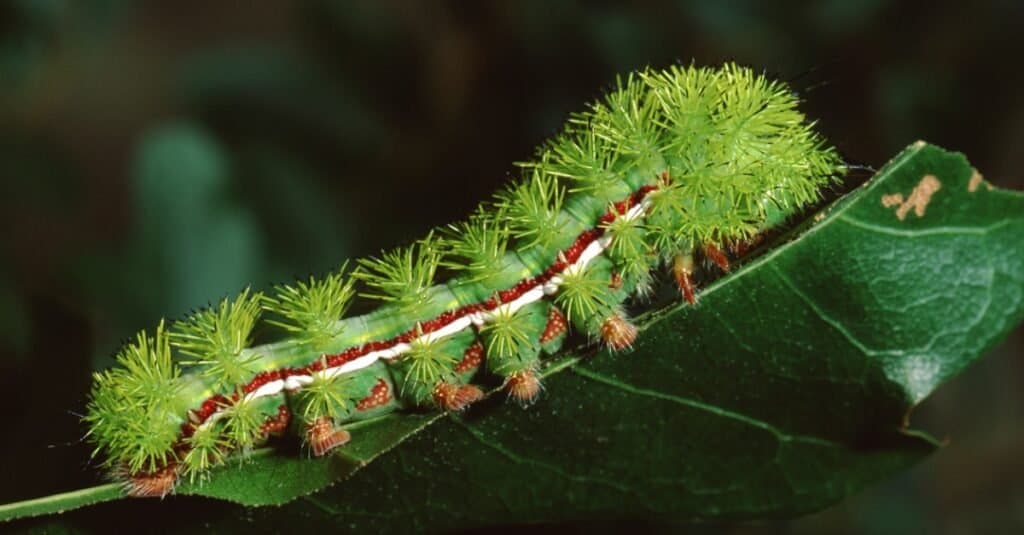
The Io
caterpillar
(pictured) has a green body.
©iStock.com/Weber
Classification: Automeris io
The Io caterpillar has an extremely peculiar appearance. You’ll find these caterpillars in Texas, Colorado, and some parts of Canada. The fact that these caterpillars have tufts of green, black, red, and white all over their bodies is one of their most distinctive features.
Keep away from these critters because they contain toxic spikes that can irritate or induce an allergic reaction. The Io caterpillar has a vivid green hue. Their largest possible size is two and a quarter inches. These caterpillars are quite dangerous, and a poke from one of their venomous spines feels like a bee sting, so use caution while handling them.
2. Banded Woolly Bear Caterpillar
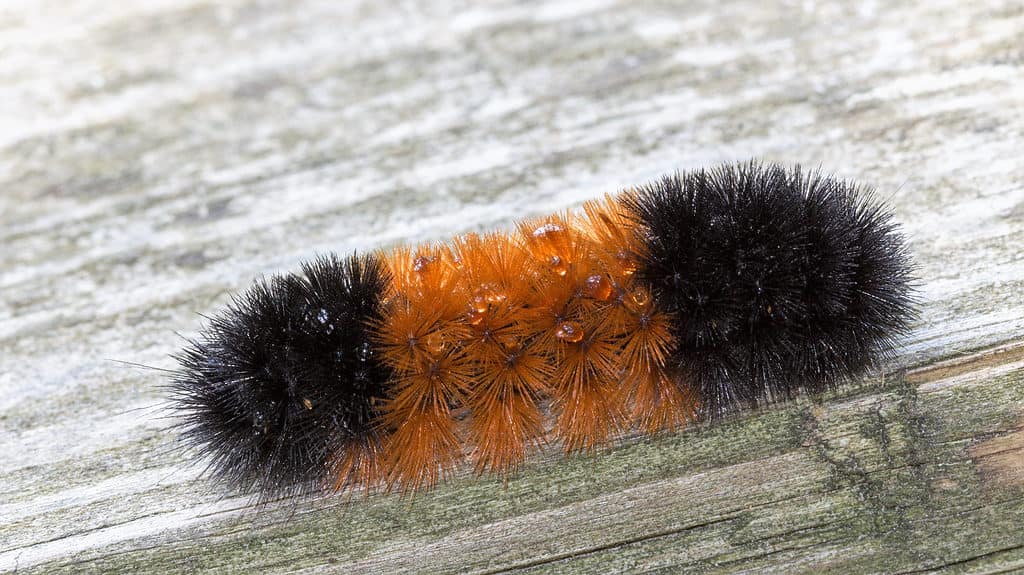
The banded woolly bear (pictured) is one of the cutest species out there.
©Kimberly Boyles/Shutterstock.com
Classification: Pyrrharctia isabella
The most prevalent variety of furry caterpillars is the banded woolly bear caterpillar. These fluffy caterpillars are easily recognized because of their brilliant orange and black patterns. The wooly worm is another name for the woolly, orange, and black Banded Woolly Bear caterpillar.
The banded woolly bear caterpillar has 13 segments that make up its body. The bristles on the caterpillars’ body covering can pierce human skin, despite the fact that they resemble soft, fuzzy creatures. Itchy skin or contact dermatitis can arise from coming into contact with one of these caterpillars. They are not toxic, though.
Due to their distinctive black hairy coating on the ends and a broad band of brown or tan hair in the center, these caterpillars are super easy to identify. When threatened, these caterpillars curl into a ball. They reach a height of a little over two inches before entering the pupal stage and eventually becoming a moth.
The harshness of winter was once thought to be predicted by banded woolly bear caterpillars. It was believed that a larger orange band in the middle of the caterpillar’s body indicated a mild winter.
3. European Gypsy Caterpillar

The European gypsy moth caterpillar (pictured) boasts a wide range of colors.
©iStock.com/grannyogrimm
Classification: Lymantria dispar
A rare species of caterpillar, the European gypsy caterpillar is often found throughout Europe, Asia, and North America. The 12 red and 10 blue spots on the back of this fluffy caterpillar make it easy to identify. They have a two-inch maximum growth potential.
The whisker-like setae of the European gypsy caterpillar protrude in all directions. While appearing innocent, these caterpillars may actually cause a lot of damage. By consuming all of the leaves of trees where they are native, they can swiftly devastate enormous forested regions. It’s advised to avoid making direct contact with them. The spines of this species can cause contact dermatitis if you touch them.
4. Salt Marsh Caterpillar

The salt marsh caterpillar (pictured) is a voracious eater.
©iStock.com/Liudmyla Lesechko
Classification: Estigmene acrea
Another member on our list of fuzzy caterpillars is the salt marsh caterpillar. This species consumes tomato, cotton, soybean, and cabbage plants. The salt marsh moth’s larvae can be any hue from light yellow to a dark, nearly black brown.
Although the black and brown coating makes this species’ bristles appear spiky, they are actually soft and not sharp. Still, the tiny fine spines can get stuck under your skin and cause mild pain or itch, much like woolly caterpillar spines.
Rows of black marks down their side set these caterpillars different from banded woolly caterpillars. These large, dark-brown, fluffy caterpillars reach a maximum length of just over two inches.
5. White-Marked Tussock Moth Caterpillar

The white-marked tussock caterpillar (pictured)has many white spines along its body.
©Satyashutter/Shutterstock.com
Classification: Orgyia leucostigma
One particularly distinguished caterpillar on this list is the white-marked tussock moth caterpillar. This caterpillar boasts a wide range of hues throughout its body. Its back is yellow and its head has a vivid red color. On the rear of the head, there are four white tufts and the tails are brown at the end.
The white-marked tussock moth caterpillar may be easily recognized thanks to its distinctive appearance. These prickly caterpillars can irritate your skin quite a bit, therefore you must exercise caution when touching them. They can reach a maximum size of one-and-a-quarter inches.
6. Sycamore Tussock Caterpillar
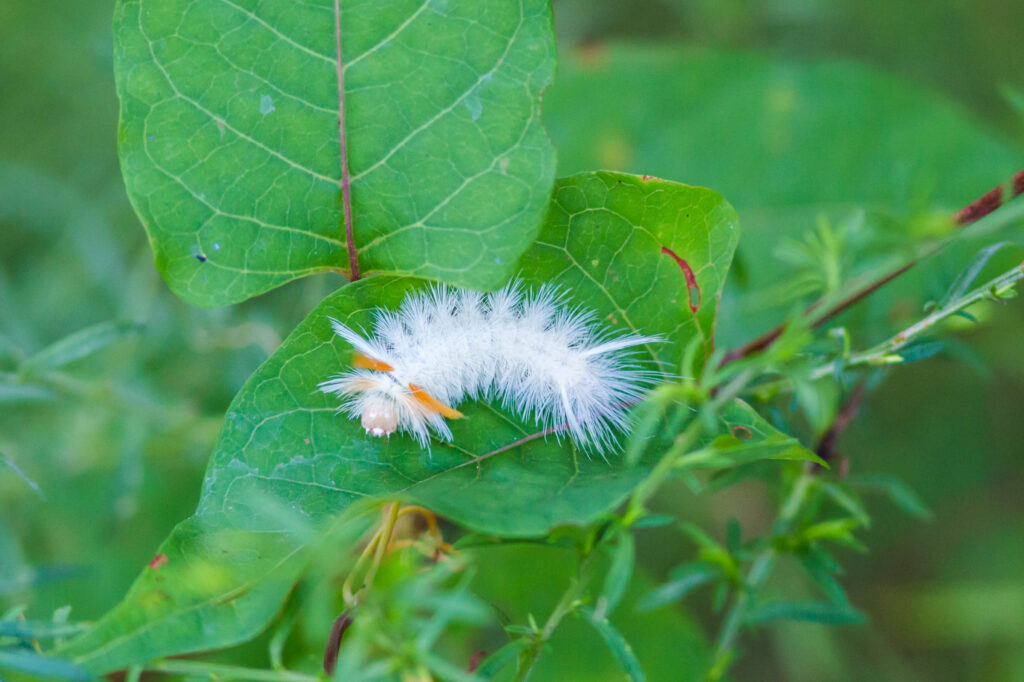
The sycamore tussock moth caterpillar (pictured) has a fluffy white appearance.
©3,295 × 2,196 pixels, file size: 663 KB, MIME type: image/jpeg – License
Classification: Halysidota harrisii
Since it has two hair pencils sticking out of each end, the sycamore tussock caterpillar has a distinctive appearance. It is white, fluffy, and hairy. Furry, yellowish-white spines protrude from the body, and it has two pairs of long, orange, and white spikes. The sides of the larvae are covered in tiny, white, bristly hairs that trail along its sides. Sycamore trees are the source of food for the sycamore tussock caterpillar. The family of crawling insects known as the Erebidae includes this species.
The sycamore tussock caterpillar has itchy bristles that might result in hives, like many other fuzzy caterpillars. These caterpillars are neither a lethal variation nor a species that will sting. A pair of white hair pencils at the back and a pair of orange hair pencils at the head help you recognize this species. These little, white, fluffy caterpillars don’t get much more than an inch long.
7. Saddleback Caterpillar
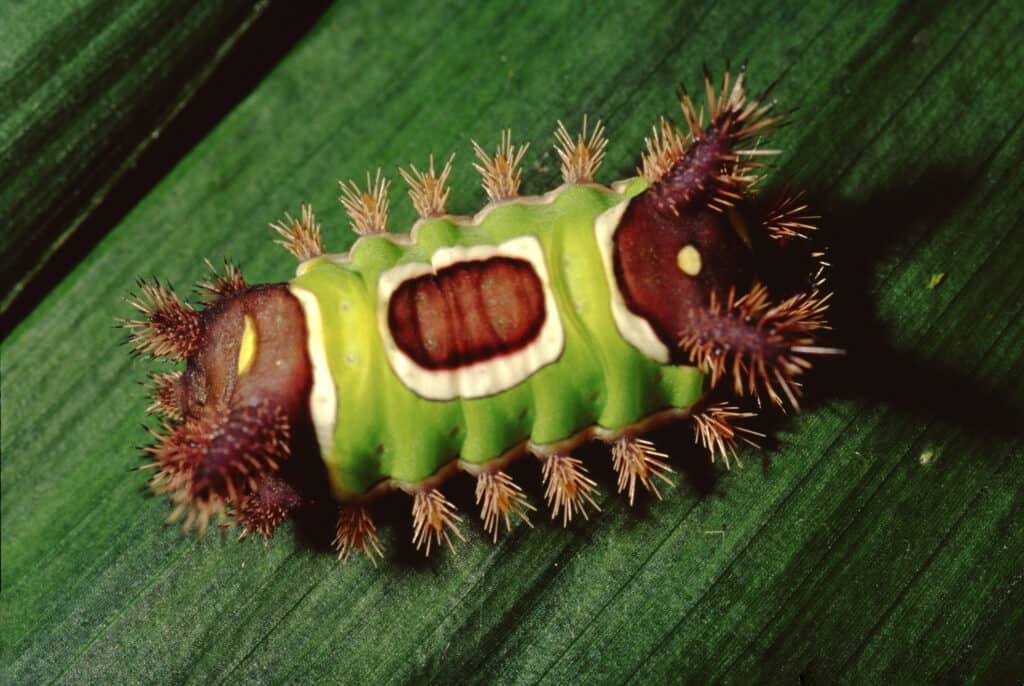
The saddleback caterpillar (pictured) is extremely easy to identify.
©Liz Weber/Shutterstock.com
Classification: Acharia stimuli
The saddleback caterpillar has quite a menacing, though very artistic appearance. These caterpillars have amazing-looking green saddle-like designs on their back. They have two spectacular eye-like structures on their head. They have long, spiky brown horns at the ends of their bodies. This species is a toxic caterpillar species, so you should avoid getting too close to them. On the human body, direct contact with their hairs can cause skin irritation and nausea.
The saddleback caterpillar can be easily recognized by the lime green saddle-shaped patch that it has on its back. They can reach a maximum size of one inch and are more spiky than hairy.
8. Hickory Tussock Caterpillar

The hickory tussock caterpillar (pictured) is known for its black spots.
©Stephanie Gelman/Shutterstock.com
Classification: Lophocampa caryae
The hickory tiger moth is another name for the larva of the hickory tussock moth. This hairy caterpillar is a black and white species from the Lophocampa genus that belongs to the same family as the sycamore tussock moth.
The larva of the hickory tussock moth is white, hairy, and coated in tufts of white setae. The hickory tiger moth larva has a pair of long, black hair pencils at either end, just like the sycamore tussock. While the white and black spines seem delicate, they are actually quite harmful. If the small hooked ends can get into your eyes or become embedded in your skin, they can really hurt.
The hickory tussock caterpillar may be distinguished from the sycamore tussock by the black bristle tufts that run down its back. The black bristles are diamond-shaped when viewed from above. The hickory species will usually reach a length of around one and a half inches, making them somewhat bigger than the sycamore caterpillar. These white spiny caterpillars turn into gorgeous brown moths with golden markings after emerging from their pupa.
9. Milkweed Tiger Caterpillar
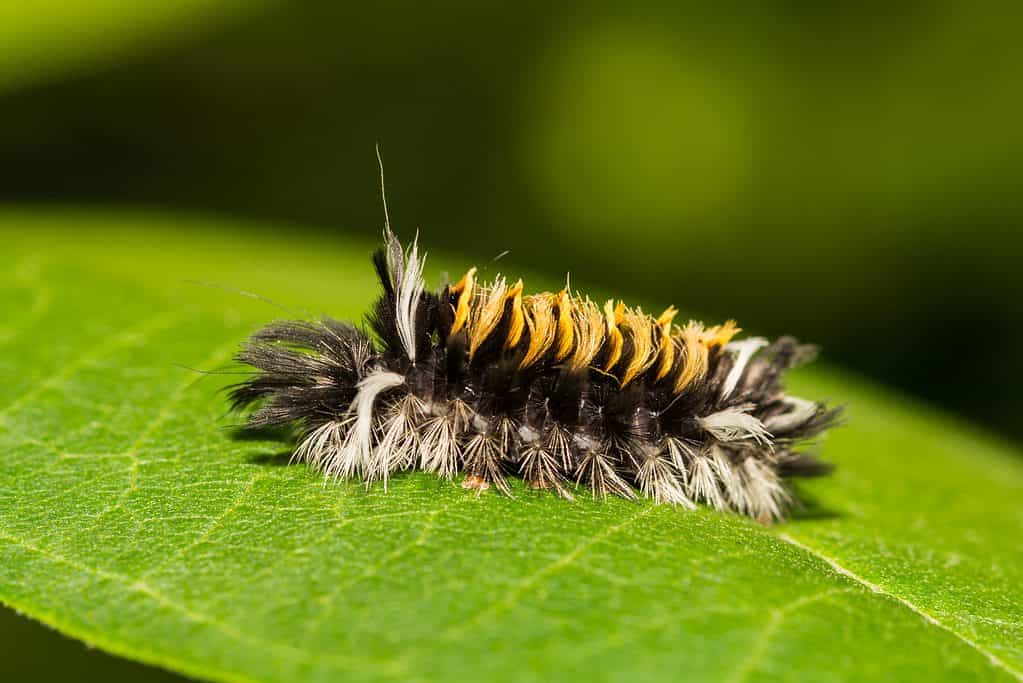
The milkweed tiger caterpillar (pictured) is also known as the milkweed tussock caterpillar.
©Jay Ondreicka/Shutterstock.com
Classification: Euchaetes egle
From Texas to southern Canada, a little type of hairy caterpillar known as the milkweed tiger can be found in forests and other areas. It is also often called the milkweed tussock moth caterpillar. This tussock species of caterpillar solely eats milkweed, as suggested by its name. The caterpillar is unaffected by the milkweed’s deadly secretion, which serves as a protection against scavengers.
The larvae of this species are darkish and hairy. The milkweed tussock moth larvae can be recognized by their black and orange fuzzy tufts. This caterpillar has an intriguing hue thanks to a few white setae tufts against the black and orange tufts. The orange patterns on the larvae are much more noticeable as they get older and closer to the pupal stage.
Identifying this species is very easy. This caterpillar is covered in fuzzy hairs in shades of black, white, and orange, with its difficult-to-see black head. It is one of the tiniest species of caterpillar, barely reaching a length of one and a quarter inches.
10. American Dagger Moth Caterpillar
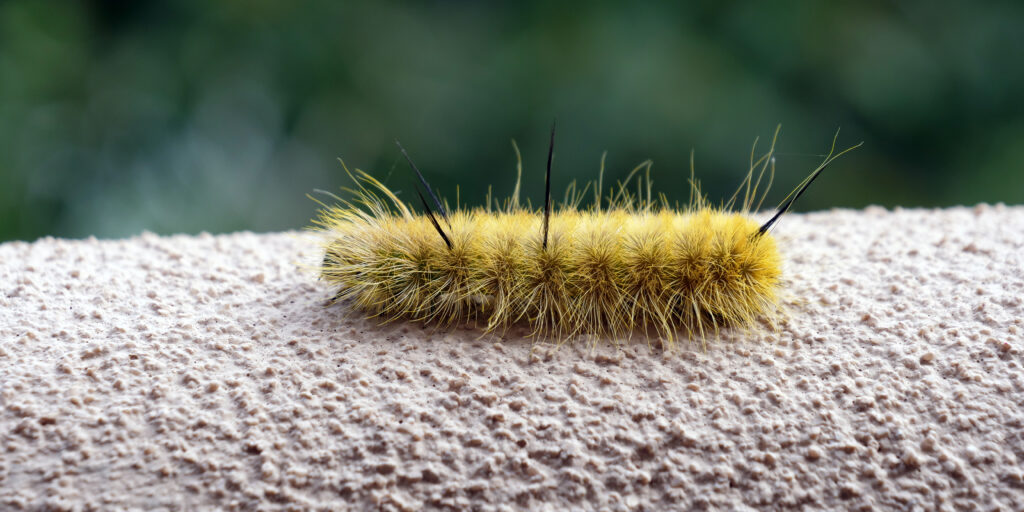
American dagger caterpillars (pictured) are cute but are very toxic.
©Martha Marks/Shutterstock.com
Classification: Acronicta americana
The American dagger caterpillar seems dangerous, but it’s actually pretty harmless. It has a long body and long, spindly, pale yellow-white hairs that give it a very delicate appearance.
The hairy American dagger caterpillar is distinguished from other species by its long, fluffy, yellow-white hairs and its shiny black head. It has two pairs of long, black-haired pencils. They can be seen towards the head end and there is only one in the back. The larva of the American dagger moth reaches a length of two and a half inches.
11. Southern Flannel Caterpillar
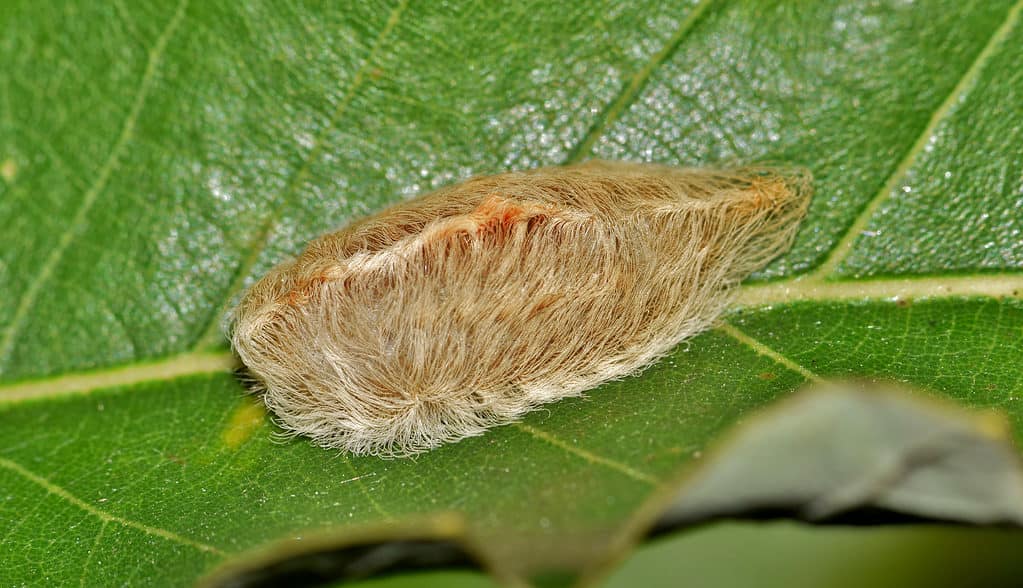
You’re seeing correctly; this southern flannel caterpillar (pictured) looks like some kind of strange little mammal!
©Brett Hondow/Shutterstock.com
Classification: Megalopyge opercularis
Now this is one crazy-looking species of fuzzy caterpillars! The southern flannel moth caterpillar is a tiny, hairy, poisonous caterpillar. It can be found in southern regions like Texas and Florida.
Setae that resemble unkempt beige-orange hair cover the larvae. Some butterfly enthusiasts claim that this species resembles a little Persian cat. Some species appear to have black with grey or yellowish speckles, while others have vivid orange fuzz. This species has a thin orange stripe can be seen on the sides of some varieties. Some of them may even have long, fluffy lemon-yellow hair on the tail.
This caterpillar’s hairy look gets messier as it gets closer to pupation. From the sides, longer, straggly orange or brown hairs begin to emerge. Despite the fact that this caterpillar appears soft and fuzzy, its venomous spines will induce a severe allergic reaction. These yellowish-furred caterpillars are common throughout the southern United States. This species prefers oak, ash, birch, and hickory trees as food.
Summary of 11 Fuzzy Caterpillars
| Caterpillar | Classification | |
|---|---|---|
| 1 | Io Caterpillar | Automeris io |
| 2 | Banded Woolly Bear Caterpillar | Pyrrharctia isabella |
| 3 | European Gypsy Caterpillar | Lymantria dispar |
| 4 | Salt Marsh Caterpillar | Estigmene acrea |
| 5 | White-Marked Tussock Moth Caterpillar | Orgyia leucostigma |
| 6 | Sycamore Tussock Caterpillar | Halysidota harrisii |
| 7 | Saddleback Caterpillar | Acharia stimuli |
| 8 | Hickory Tussock Caterpillar | Lophocampa caryae |
| 9 | Milkweed Tiger Caterpillar | Euchaetes egle |
| 10 | American Dagger Moth Caterpillar | Acronicta americana |
| 11 | Southern Flannel Caterpillar | Megalopyge opercularis |
The photo featured at the top of this post is © 3,295 × 2,196 pixels, file size: 663 KB, MIME type: image/jpeg – License / Original
Thank you for reading! Have some feedback for us? Contact the AZ Animals editorial team.






